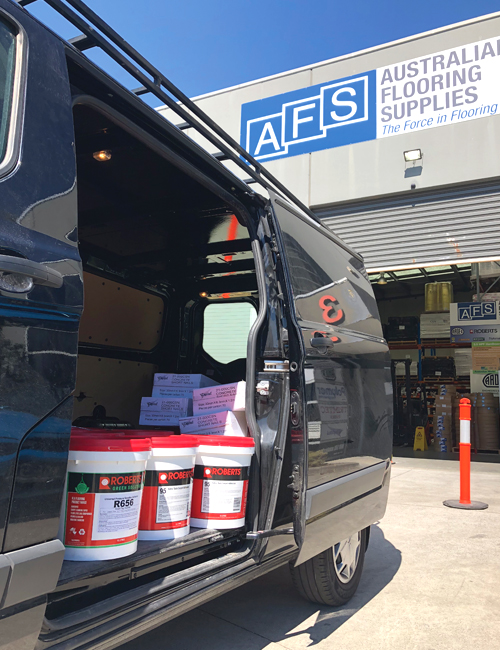Flooring Magazine sat down with industry stalwarts Australian Flooring Supplies to discuss the flooring adhesives market. Here’s what they had to say.
The adhesives market has changed dramatically over recent years as manufacturers have raced to keep speed with ever evolving flooring products.
New manufacturing methods, new raw materials and a consumer demand for better visuals has resulted in a rapid evolution of flooring products.
The result has been new adhesive products better suited to modern flooring, new best practices and a more competitive adhesives market offering more choice.
The evolution of luxury vinyl tile (LVT) and the resulting changes in resilient adhesives is the perfect example of the in tandem evolution of adhesives and flooring.
When ‘loose lay’ vinyl planks were first released there were concerns that adhesive sales would suffer.
However, these concerns were short lived as there were many issues with installing these products without adhesives.
Adhesive manufacturers responded to these issues by recommending pressure sensitive (PS) adhesives.
One benefit of PS adhesives is the ability to spread adhesive through the whole job prior to plank installation.
Installers loved this feature as it greatly reduced total install time.
But unfortunately, the use of PS adhesives didn’t resolve the vinyl plank shrinkage issues.
In response to plank shrinkage and movement, manufacturers begun recommending the use of hard-set adhesives with all vinyl planks and resilient floor coverings. This proved to be a good move with more successful installations and less complaints. Installation may take longer with hard-set adhesives when installing luxury vinyl tiles and installers need to ensure that there is good transfer of adhesive on the back of the planks. But a successful installation with no comebacks is worth the extra effort.
The use of hard-set adhesives is now common place for vinyl installations, with domestic and commercial vinyl installers preferring one with a good open time and fast set up time (i.e. Roberts 285 and R2000).
Meanwhile, the introduction of one-component heavy duty adhesives (i.e. ARDEX AF 180 MS) has revolutionised the installation of commercial resilient wall and floor coverings in extreme conditions, such as ensuites and other wet areas.
Launched as a replacement for two-part epoxies in wet areas, one-component adhesive benefits include no mixing and no waste. One-component adhesives have been well received by commercial vinyl installers and sales are increasing.
Carpet adhesives have also undergone huge changes.
As carpet tiles have increased in popularity, direct stick or dual bond installations have decreased in popularity. This has seen traditional acrylic carpet adhesive sales drop, but sales of PS adhesives for carpet increase.
PS adhesives come in liquid form in buckets or in spray canisters. Spray PS adhesives are commonly available in 22kg disposable canisters or 600ml aerosol cans.
Spray PS adhesives in aerosol cans are best suited for small repairs. For carpet tiles with non-PVC backings in larger jobs the 22kg canisters are better suited as they are more economical.
There are three major advantages of using spray PS adhesives in carpet tile installations.
Firstly, spray PS adhesives are much faster to apply. Secondly, unlike the traditional method of application from an adhesive bucket there is no waste. When an adhesive bucket is used waste is caused by the roller or trowel introducing residual dust or dirt back into the adhesive bucket. Approximately 5% to 10% of each bucket of PS adhesive is disposed of during a typical install. Therefore, using a spray pressure sensitive adhesive represents a significant cost saving as you can use every gram of adhesive purchased.
Thirdly, installers don’t have to be on their knees to apply the adhesive therefore saving their bodies from another backbreaking task.
It’s quick, it’s easy and it’s clean.
Despite these benefits some installers still prefer to roll pressure sensitive adhesive in liquid form straight out of the bucket, hence the evolution of rectangular buckets.
This is a decent option but the cost of paint rollers, wastage, time and installer fatigue needs to be considered.
The number of players in the adhesives market has also increased resulting in healthy competition and increased innovation.
For instance, adhesive manufacturers have long recommended the use of specific types of flooring adhesives dependent on the floor covering being installed. But flooring manufacturers have been getting in on the action too and are now marketing their own branded adhesives. In addition to diversifying their product range, the move also protects flooring manufacturers from finger pointing if there is ever a complaint.
As long as the intent is to improve performance and minimise complaints, and ensure that any complaints that may arise are dealt with fairly and quickly, this move can only be a good one for the industry. Because at the end of the day the results will include; a wider choice of similar adhesives at different price points for installers to choose from, greater competition and more investment in innovation.
However, despite the buffet of options available it is always prudent to follow the adhesive manufacturer’s recommendations to limit failures.
Meanwhile, European technology has become extremely influential in the resilient floor covering adhesives market. This new technology has delivered better bonding qualities, improved spread rates, better working times and in most cases, they are also environmentally friendly.
The flooring adhesive world is in a state of positive change with new product developments, increased competition and more choice for installers. The pace of development is unlikely to slow – so, as they say, watch this space!

